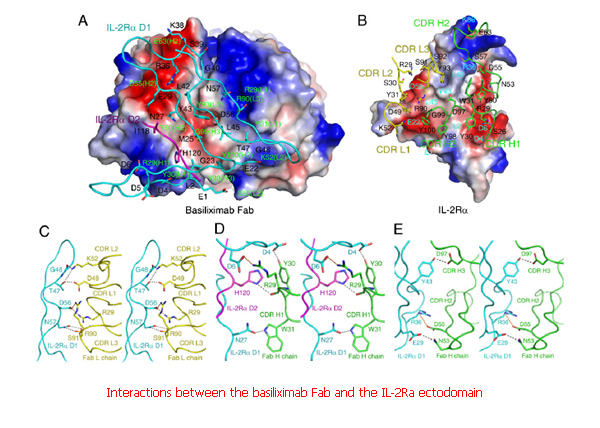Researchers in SIBCB discover the structural basis for the blockage of IL-2 signaling by therapeutic antibody basiliximab
Source:
Time: 2010-01-27
The latest finding of DING Jianping´s Group at the Institute of Biochemistry and Cell Biology (SIBCB), Shanghai Institutes for Biological Sciences (SIBS), Chinese Academy of Sciences was recently published on a renowned journal the Journal of Immunology. His group discovered the the molecular mechanisms of inhibition of IL-2 signaling by basiliximab (Simulect®, Novartis). Since 2007, the DING group has published a series of papers on the structural and functional studies of important therapeutic antibodies in complexes with their corresponding antigens.
IL-2 signaling plays a pivotal role in the initiation and activation of immune responses. The activation of T cells through the IL-2 signaling is initiated by the binding of IL-2Rα to IL-2. Intriguingly, IL-2Rα is not expressed on resting T and B cells but abundantly expressed on activated T cells, especially by the T cells participating in some pathological conditions such as organ allograft rejection, some autoimmune diseases, and T cell leukemia. The critical role of IL-2Rα in the IL-2 signal pathway and its specific expression pattern make it a good clinical target.
Basiliximab, a therapeutic mAb drug against IL-2α of T cell, has been widely used for the prevention of allograft rejection in organ transplantation, especially in kidney transplants. To investigate the structural basis of blockage of the IL-2 signaling and special recognition of IL-2Rα by basiliximab, Dr. Jiamu Du et al. determined the crystal structure of the basiliximab Fab in complex with the ectodomain of IL-2Rα. In the complex structure, the Fab interacts with IL-2Rα with extensive hydrophilic and hydrophobic interactions, accounting for a high binding affinity. Structural analysis of the basiliximab Fab/IL-2Rα complex and its comparison with the crystal structures of the IL-2/IL-2Rα and IL-2/IL-2Rαβγc complexes provide insights into the molecular mechanism of the inhibition of the IL-2 signal pathway by basiliximab. The Ag binding site of basiliximab consists of all six CDR loops and the discontinuous epitope of IL-2Rα recognized by basiliximab is composed of several segments from the two domains that overlap with most of the regions responsible for the interactions with IL-2. In the presence of a sufficient amount of basiliximab, the IL-2 binding site of IL-2Rα would be blocked, and thus IL-2 signaling cannot be initiated and executed due to the lack of binding of IL-2 to IL-2Rα and the formation of the functional IL-2/IL-2Rαβγc complex. These results also provide important implications for the development of improved and new IL-2Rα-targeted mAb drugs.
This work was supported by grants from the Ministry of Science and Technology of China, the National Natural Science Foundation of China, the Chinese Academy of Sciences, and the Science and Technology Commission of Shanghai Municipality.


 Appendix:
Appendix: